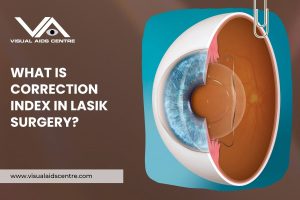Table of Contents
ToggleYes, the flap is lifted during LASIK surgery as part of the vision correction process. This surgical step is a critical component of the procedure, enabling access to the cornea for reshaping.
LASIK, short for Laser-Assisted in Situ Keratomileusis, is one of the most popular types of refractive eye surgery designed to correct vision issues such as nearsightedness, farsightedness, and astigmatism. A defining feature of LASIK compared to other procedures is the creation and utilisation of a corneal flap. For those considering LASIK, understanding the role and process of flap lifting is essential to make informed decisions about the procedure.

What is the Flap in LASIK?
The flap in LASIK refers to a thin, hinged layer of corneal tissue that is created during the initial phase of the surgery. This flap is critical because it allows the surgeon to access the inner layers of the cornea without damaging the delicate outer layers.
The flap itself acts as a natural bandage once replaced, promoting faster recovery and minimising discomfort after surgery. Think of it as a protective layer that safeguards the healing cornea underneath.
Why is the Flap Lifted?
The lifting of the corneal flap is an essential step that distinguishes LASIK from other vision correction procedures like PRK (Photorefractive Keratectomy). The purpose of lifting the flap is to expose the middle layer of the cornea, known as the stroma. This layer is reshaped using a specialised laser to correct refractive errors.
By lifting the flap, the surgeon can access the stroma without removing or disturbing the epithelium (the outermost layer of the cornea). This approach contributes to a quicker recovery and less post-surgical discomfort compared to techniques where the epithelium is removed entirely.
Benefits of the Flap Method in LASIK
- Preservation of the Epithelium: The flap preserves the outermost corneal tissue, aiding a more comfortable and faster recovery.
- Reduced Healing Time: Patients often return to normal activities within a day or two.
- Enhanced Precision: Lifting the flap allows precise and controlled access to the corneal stroma for laser reshaping.
How is the Flap Created?
The creation of the corneal flap is one of the most intricate steps of LASIK surgery. It demands precision, skill, and the use of advanced technology.
Methods of Flap Creation
1. Microkeratome Blade:
Traditionally, a microkeratome (a precise mechanical blade) was used to create the flap. While effective, this method has largely been replaced by newer technologies.
2. Femtosecond Laser:
Most modern LASIK surgeries use a femtosecond laser to create the corneal flap. This technology allows for unparalleled accuracy and customisation, creating a thinner, more precise flap with reduced risk of complications.
The Flap Lifting Process
Once the flap is created, it remains attached to the cornea on one side, acting like a hinge. This hinged design makes it easy for the surgeon to lift and later reposition the flap without causing damage. The surgeon carefully lifts the flap to expose the corneal stroma, ensuring the rest of the tissue remains intact.
What Happens After the Flap is Lifted?
After lifting the flap, the surgeon uses an excimer laser to reshape the corneal tissue underneath. The laser emits cool ultraviolet light to remove microscopic amounts of tissue with extreme precision. This reshaping alters the way light is focused on the retina, correcting the refractive error and improving vision.
Once the reshaping is complete, the corneal flap is repositioned to its original place. The flap adheres naturally without the need for sutures, as the corneal tissue bonds quickly.
Does the Flap Heal After LASIK?
Yes, the flap heals securely, but not permanently. Within hours, the natural adhesion of the corneal tissue helps the flap stay in place. Over the following weeks, the healing process continues, although the flap itself does not fuse back into the cornea permanently. This is why patients are advised to avoid rubbing their eyes or doing anything that might dislodge the flap during the early recovery period.
- Short-term Healing:
- The initial healing process takes about 24-48 hours.
- Most patients report significant improvement in vision within the first day.
- Long-term Stabilisation:
- Full stabilisation of the corneal tissue typically occurs within 2-3 months.
- Regular follow-ups ensure proper healing.
Risks and Complications of Flap Lifting
While LASIK is considered safe and effective, lifting and repositioning the flap is not entirely without risks. Understanding potential complications helps in making an informed choice.
Flap-related Risks
- Flap Displacement:
If the eye experiences trauma shortly after surgery, the flap can become displaced. Though rare, this underscores the importance of following post-operative care instructions.
- Epithelium Growth under the Flap:
Occasionally, epithelial cells may grow under the flap, requiring minor surgical intervention.
- Flap Wrinkling (Striae):
Sometimes, small wrinkles can form in the flap if not positioned correctly, although these are typically corrected during post-op follow-ups.
Mitigating Risks
Choosing a skilled and experienced surgeon significantly reduces the likelihood of flap-related complications. Additionally, modern advancements in LASIK technology, such as femtosecond laser-assisted flap creation, have made the process safer and more reliable.
How Does Flap Lifting in LASIK Compare to Other Procedures?
LASIK’s flap-based methodology sets it apart from other corrective eye surgeries like PRK and SMILE (Small Incision Lenticule Extraction):
LASIK vs PRK
- Flap in LASIK:
- Provides faster recovery.
- Reduces discomfort.
- No Flap in PRK:
- Suitable for patients with thin corneas.
- Longer recovery time as the epithelium regenerates.
LASIK vs SMILE
- Flap in LASIK:
- Offers broader applicability for various refractive errors.
- Established as a proven method for decades.
- SMILE:
- Utilises a small incision instead of a flap.
- Newer technique with a more limited scope of correction.
Post-operative Care for Flap Protection
Proper care and adherence to guidelines ensure the flap remains in position and heals effectively:
- Avoid Eye Rubbing:
Especially in the first week post-surgery, as this may displace the flap.
- Use Protective Shields:
Wear the prescribed shields while sleeping to prevent accidental damage.
- Administer Eye Drops:
Use medicated and lubricating drops as directed by your surgeon to prevent infection and dryness.
Keeping up with follow-up appointments is also essential to monitor recovery and address any concerns promptly.
Should You Worry About the Flap?
For most patients, the creation and lifting of the flap are straightforward and uneventful. Skilled surgeons and advanced technology have made LASIK an incredibly safe and effective procedure for vision correction. If you’re considering LASIK, it’s worth discussing any concerns about the flap or the procedure itself with your surgeon during the consultation.
Final Thoughts
The lifting of the flap in LASIK is a key step that allows precise reshaping of the corneal tissue to improve vision. Modern technology ensures that this process is both safe and efficient. Understanding the role of the corneal flap, its benefits, and the associated care can help you make an informed decision about whether LASIK is right for you.
If you’re considering LASIK, consult an experienced surgeon to discuss your suitability and the specifics of the procedure. Rest assured, the modern flap creation and lifting process have revolutionised vision correction, offering millions of people a clearer view of the world around them.













